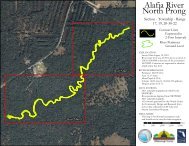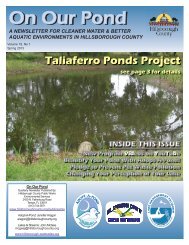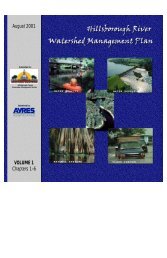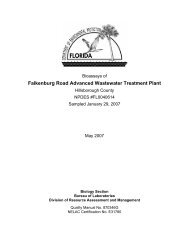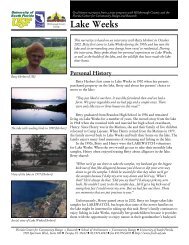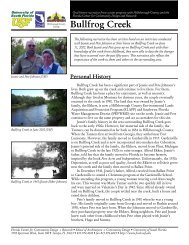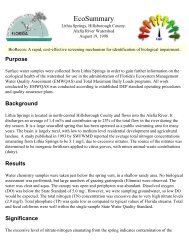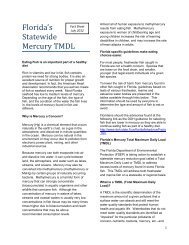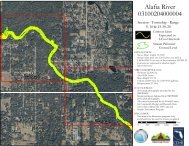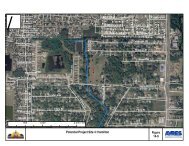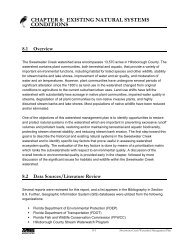Rocky Brushy Creek Watershed Mgmt. Plan (2007) -- Part 2
Rocky Brushy Creek Watershed Mgmt. Plan (2007) -- Part 2
Rocky Brushy Creek Watershed Mgmt. Plan (2007) -- Part 2
You also want an ePaper? Increase the reach of your titles
YUMPU automatically turns print PDFs into web optimized ePapers that Google loves.
CHAPTER 8Wild TaroThe wild taro is an emergent plant, imported from the Pacific Islands. Itoccurs in and out of water. The leaves can grow to two feet long and aremedium to large in size, arrowhead-shaped with heart-shaped bases. Theyare dark, velvety green, and water repellant. Wild taro leaves are peltate: theleaf stem attaches more-or-less to the middle of the underside of the leaf.Leaf stems grow to four feet tall, and flowers occur in small fingerlike spikes.It is established in backwater areas of <strong>Rocky</strong>/<strong>Brushy</strong> <strong>Creek</strong>.Hydrilla, a submerged aquatic plant, grows rooted in the bottom substrate of quiet reaches of the<strong>Creek</strong> and other freshwater habitats. It escaped from the aquarium trade and is well established instream reaches of <strong>Rocky</strong> and <strong>Brushy</strong> <strong>Creek</strong>s and in some lakes in the watershed. Controlmeasures include chemical treatment and the introduction of the Chinese grass carp, a planteatingfish species.8.5.9.2 Exotic FaunaAn exotic animal is a non-indigenous species introduced to an area either purposefully oraccidentally. Exotic, non-indigenous, invasive species compete with native species for space, food,and ecological niche. Activities to prevent and control invasive animal species that severely impactthe lands and waters of the United States have become a priority for watershed management. Theterm invasive species is defined by the Presidential Executive Order 13112. Known as "exoticinvasive"or "alien-invasive" species, these invasive plants and animals cause vast ecological andeconomic damage, and sometimes, human health impacts in areas that they infest. These specieshave gained a foothold on public and private lands throughout the nation and in other parts of theworld, and range across almost every ecosystem of the country including those found within the<strong>Rocky</strong>/<strong>Brushy</strong> <strong>Creek</strong> watershed. Common methods of introduction include release of pets, escapefrom pet dealers, or intentional introduction for pest control. USGS, FDEP, UF-IFAS, andHillsborough County information on non-indigenous species were reviewed to compile a list ofexotic species that have been observed or reported in the watershed. Some of the exotic animalspecies found in the watershed include: Nine-banded armadillo, Cuban tree frog, Greenhouse frog,and Brown anole. These four species arrived in Florida by natural migration (nine-bandedarmadillo) and by accidental introduction (Cuban tree frog, Greenhouse frog, and Brown anole).Armadillos disturb soils in all habitats, particularly Stream and Lake Swamp, Cypress, and otherwetlands during the dry season. The Cuban treefrog is a voracious predator and will attack anddevour anything smaller than itself, including native frogs, fish, and invertebrates. The greenhousefrog may be replacing native frogs, particularly in south Florida, while the brown anole competes tosome degree with the native Carolina anole (chameleon).8-41<strong>Rocky</strong>/<strong>Brushy</strong> <strong>Creek</strong> <strong>Watershed</strong> Management <strong>Plan</strong>



